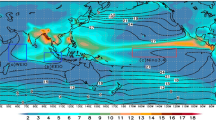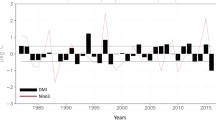Abstract
The summer monsoon contributes to about 75 % of mean annual rainfall over the various meteorological subdivisions of India. The role of ocean–atmosphere phenomena such as Indian Ocean Dipole (IOD) and El Nino–Southern Oscillation (ENSO) on the Indian monsoon activity is intriguing. The impacts of ENSO, IOD and Equatorial Indian Ocean Oscillation on monsoon are distinct. The ENSO (IOD) in general affects the monsoon negatively (positively). The present study aims to understand the role of different types of IOD such as early IOD (EIOD), normal IOD and prolonged IOD (PIOD) on Indian Summer Monsoon Rainfall (ISMR). We find that an EIOD, which peaks in the mid-monsoon months (July and August), plays a significant role like PIOD in enhancing ISMR even though it has a medium Dipole Mode Index amplitude value compared to other IODs. During an EIOD, the combined effect of excess evaporation from Arabian Sea and the stronger cross-equatorial flow leads to the enhanced monsoon activity. In addition, there is a substantial decrease in the number of break spells during EIOD years.




Similar content being viewed by others
References
Ashok K, Guan Z, Saji NH, Yamagata T (2004) Individual and combined influences of ENSO and the Indian Ocean Dipole on the Indian Summer Monsoon. J Clim 17:3141–3155
Behera SK, Krishnan R, Yamagata T (1999) Unusual ocean–atmosphere conditions in the tropical Indian Ocean during 1994. Geophys Res Lett 26:3001–3004
Du Y, Cai W, Wu Y (2013) A new type of the Indian Ocean Dipole since the Mid-1970s. doi:10.1175/JCLI-D-12-00047.1, 2013. American Meteorological Society, 1 February 2013
Kalnay E, Kanamitsu M, Kistler R, Collins W, Deaven D, Gandin L, Iredell M, Saha S, White G, Woollen J, Zhu Y, Leetmaa A, Reynolds R (1996) The NCEP/NCAR 40-year reanalysis project. Bull Am Meteorol Soc 77:437–470
Krishnamurthy V, Shukla J (2000) Intraseasonal and interannual variability of rainfall over India. J Clim 13:4366
Li T, Zhang Y, Chang C-P, Wang B (2001) On the relationship between Indian Ocean sea surface temperature and Asian Summer Monsoon. Geophys Res Lett 28(14):2843–2846
Najundiah RS, Francis PA, Ved M, Gadgil S (2013) Predicting the extremes of Indian summer monsoon rainfall with coupled ocean–atmosphere models. Curr Sci 104(10):1380–1393
Rajeevan M, Gadgil S, Bhate J (2008) Active and break spells of the Indian Summer Monsoon. NCC report, 2008
Ramesh Kumar MR, Schluessel P (1988) Air–sea interaction over the Indian Ocean during the two contrasting monsoon years 1987and 1988 studied with satellite data. Theor Appl Climatol 60:219–231
Ramesh Kumar MR, Uma RPD (2004) A new criterion for break in monsoon conditions over the Indian subcontinent. Geophys Res Lett 31:18201
Ramesh Kumar MR, Krishnan R, Sankar S, Unnikrishnan AS, Pai DS (2009) Increasing trend of break-monsoon conditions over India-role of ocean–atmosphere processes in the Indian Ocean. IEEE Geosci Remote Sens Lett 6(2):332–336
Sadhuram Y, Ramesh Kumar MR (1988) Does evaporation over the Arabian Sea play a crucial role in moisture transport across the west coast of India during an active monsoon period? Mon Weather Rev 116:307–312
Sahai AK, Grimm AM, Satyan V, Pant GB (2003) Long-lead prediction of Indian Summer Monsoon rainfall from global SST evolution. Clim Dyn 20:855–863
Saji NH, Goswami BN, Vinayachandran PN, Yamagata T (1999) A dipole mode in the tropical Indian Ocean. Nature 401:360–363
Swapna P, Ramesh Kumar MR (2002) Role of low level flow on the summer monsoon rainfall over the Indian subcontinent during two contrasting monsoon years. J Ind Geophys Union 6:123–137
Webster PJ, Magana VO, Palmer TN, Shukla J, Tomas RA, Yanai M, Yasunari T (1998) Monsoons: processes, predictability and the prospects for prediction. J Geophys Res 103(c7):14451–14510
Yu L, Jin X, Weller RA (2008) Multidecade global flux datasets from the objectively analyzed air–sea fluxes (OAFlux), OA flux project technical report. OA-2008-01. Woods Hole, 2008, 64 pp
Acknowledgments
The authors gratefully acknowledge IMD for providing rainfall data. Ms. Nisa Anil acknowledges the support from Monsoon Mission project (Ministry of Earth Sciences) and Mr. Baby Chakrapani for his motivation in this research work. We sincerely thank two anonymous reviewers for reviewing this paper. We used Ferret software for preparing figures.
Author information
Authors and Affiliations
Corresponding author
Rights and permissions
About this article
Cite this article
Anil, N., Ramesh Kumar, M.R., Sajeev, R. et al. Role of distinct flavours of IOD events on Indian summer monsoon. Nat Hazards 82, 1317–1326 (2016). https://doi.org/10.1007/s11069-016-2245-9
Received:
Accepted:
Published:
Issue Date:
DOI: https://doi.org/10.1007/s11069-016-2245-9




